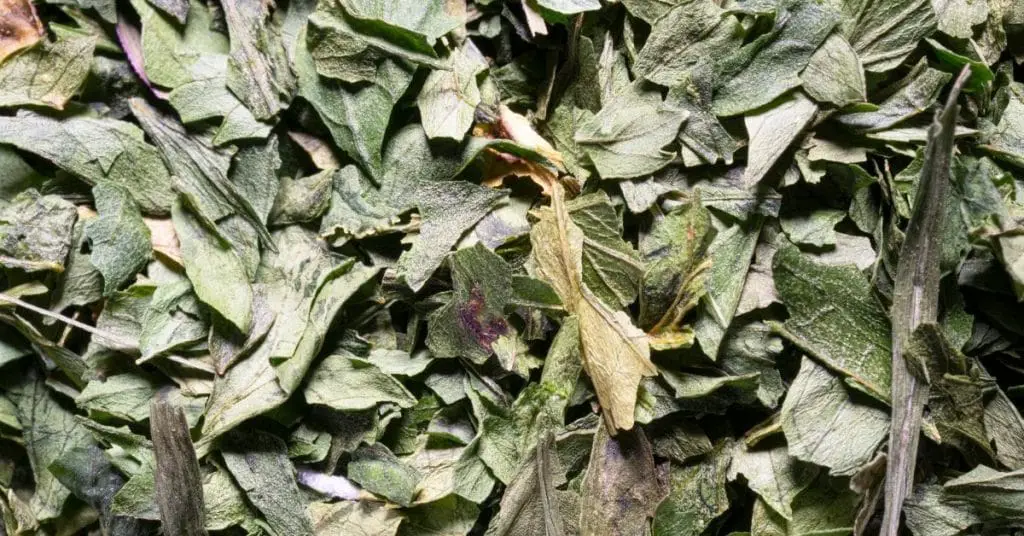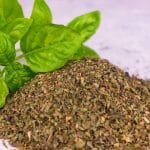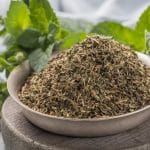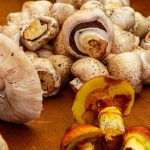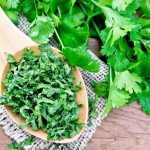In short, you can use one of three methods to dry parsley: microwave, oven-dry, or air-dry the leaves after cleaning and blanching them.
Parsley is a bright green herb used as a garnish or flavoring in savory cooking. Parsley has a high water content and only lasts a few days in the refrigerator. Drying parsley is a great way to preserve it for up to a year.
There are a few different ways to dry parsley depending on the time and equipment you have available.
In this guide, you will learn how to successfully dry parsley.
Can You Dry Parsley?
Yes, you can dry fresh parsley to prolong its shelf life for up to a year. There are several ways to dry fresh herbs including air-drying, microwaving, and oven-drying. A food dehydrator can also be used.
When drying parsley, it is important to make sure that excess moisture is completely eliminated before packing as mold will develop if moisture is present.
If you live in a very humid climate, it is advisable not to air-dry your parsley by hanging. The moisture in the air will slow the drying process and the leaves may start to mold before they have a chance to fully dry out. Air-drying is, however, ideal if you live in a hot, dry climate.
Always store dried parsley in an airtight container in a cool, dry place out of direct sunlight.
How To Dry Parsley
Use these methods to turn fresh parsley to dried parsley.
Method 1: Microwave
Step 1: Clean
If the fresh parsley leaves are dirty, wipe them lightly with a dry or damp cloth. You want the leaves to be as dry as possible before starting the dehydration process. You can also use a salad spinner to get them dry.
Remove all the parsley leaves from the stem.
Step 2: Prepare
Place a piece of paper towel onto a microwaveable plate. Spread the leaves on the paper towel in a single layer so that they do not touch each other. Lay the larger, thicker leaves on the outer part of the plate as this is the hottest part. Place another paper towel on top of the leaves.
Step 3: Microwave
Microwave the leaves on high power for one minute. Check the leaves. If they are not completely dry, keep microwaving them in 15-second intervals.
Step 4: Pack
When the leaves are completely dried out and brittle, remove them from the microwave. Allow the leaves to cool for a minute. Crush the dried leaves with a mortar and pestle or with your fingers.
Pack the dried parsley into spice bottles, mason jars, or resealable bags. Label the jar with the date and contents.
Method 2: Oven-Dry
Here’s how to dry parsley in the oven
Step 1: Rinse
Lightly rinse the parsley in cold water. Remove the leaves from the stems.
Step 2: Blanch
Heat a small pot of water on the stovetop until boiling. Submerge the parsley leaves in the boiling water for 15 to 20 seconds only. Immediately rinse with cold water to stop the cooking process.
Step 3: Dry
Place the cooled, wet leaves on paper towels or clean kitchen towel and pat them dry. Remove as much excess moisture as possible.
Step 4: Prepare
Spread the leaves out in a single layer on a parchment-lined baking sheet. Make sure the leaves are not clumped together and don’t touch each other.
Step 5: Bake
Using the lowest temperature setting, place the baking sheet in the oven and bake for 2 hours. If the leaves are not dried after two hours, let them continue to bake on the lowest setting.
Check on them regularly to ensure they do not burn. The time required to dry the leaves will depend on the humidity in the air and can take up to four hours.
Once the leaves are crispy and crumble easily, they are ready to be removed from the oven.
Step 6: Crush and Pack
Remove any overlooked stalks from the dried herbs. Crush the leaves and store the dried parsley flakes in labeled resealable containers.
Method 3: Air-Dry by Hanging
Step 1: Clean
Wipe any dirt off the leaves with a clean, dry, or slightly damp cloth if needed. Do not wash the leaves in water. You want to keep the parsley as dry as possible.
Step 2: Tie Bundles
Tie a bundle of parsley stalks together with an elastic or string. Don’t make the bundles too big to ensure air can circulate evenly throughout the bundle.
Step 3: Hang
Hang the parsley bundles to dry with the leaves hanging downwards. Choose a light area with good air circulation to hang the bundles. Avoid humid areas such as near a stove or bathroom.
To protect the herbs from dust, cover each bundle with a perforated brown paper bag. Punch holes in the bag and leave the bottom open. Do not use plastic as this will prevent airflow and cause mold.
After 2 weeks, the leaves should be dry, shriveled, and brittle. Completely dry leaves should crumble easily when you handle them.
Step 4: Pack
Remove the leaves from the stems and crumble them into small pieces. Store the dried, crushed herbs in glass jars or a container with a lid and label it with the date and contents.
Types of Parsley
Parsley’s bright green color and frilly leaves make it a great addition of color to dishes. Fresh parsley is generally divided into 3 main classifications:
- Curly leaf parsley is used mainly as a garnish, freshly chopped and sprinkled over salads, vegetables, meat, rice, and fish dishes.
- Flat leaf parsley does not have frilly leaves but is used in similar applications to curly leaf parsley. It serves as a garnish and flavoring in stocks, sauces, soups, stews, and casseroles. It is a key ingredient in making falafels, giving chickpea fritters their green color.
Both flat leaf and curly leaf parsley are used as the main ingredient in condiments such as pesto and gremolata.
- Root parsley is used as a vegetable or snack in soups, stews, broth, and casseroles.
FAQs
Conclusion
Parsley is an incredible herb for garnishing and seasoning. The strongly flavored herb is versatile for use in almost any type of savory dish including meats, vegetables, seafood, dressings, stews, and soups.
Before packing your parsley, make sure that the herbs are completely dry and crunchy. If they are still slightly pliable and do not crumble easily when handled, they need more drying time. Not drying the herbs completely will shorten their lifespan due to mold developing.
Enjoy sprucing up your cooking with these naturally dried herbs for up to a year.
Check our other guides on how to dry basil leaves, and oregano leaves.
Up next: Substitute for Parsley
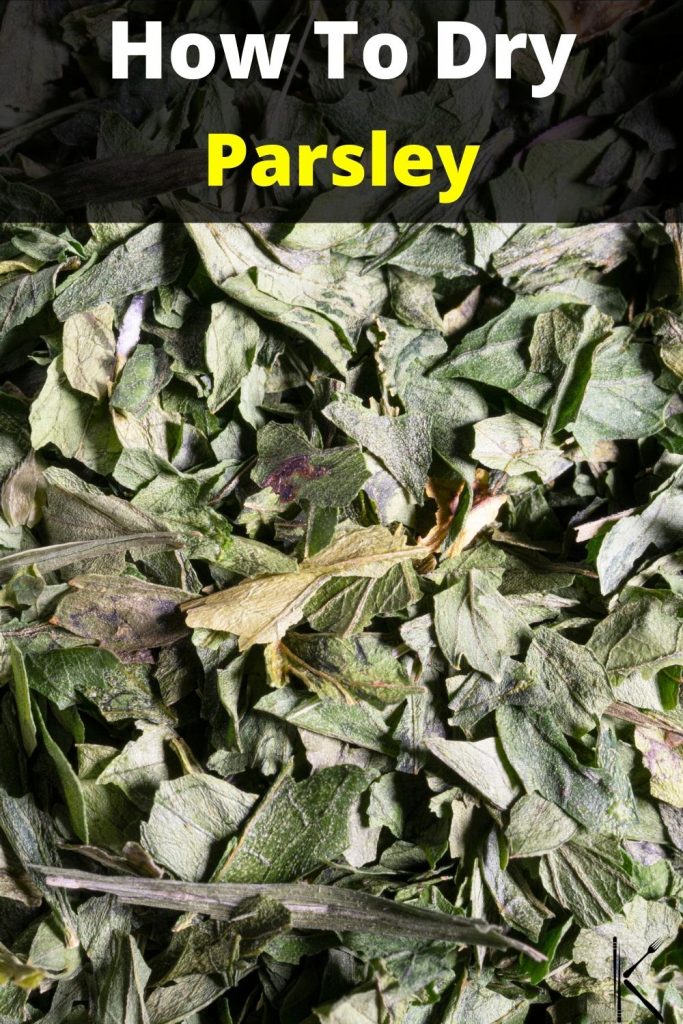
*image by sergiodv/depositphotos
